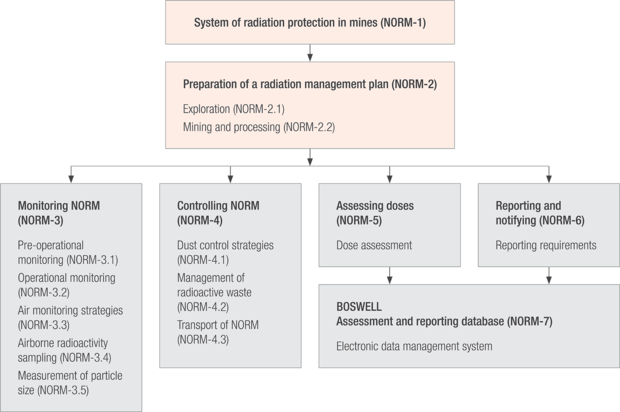On 31 March 2022, the Work Health and Safety (WHS) laws replaced the health and safety elements of the Mines Safety and Inspection laws. For information visit www.demirs.wa.gov.au/whs
All health and safety notifications, forms and guidance for mining and petroleum has moved to the WorkSafe website
Regulatory framework
Co-regulation with Radiological Council
Radiation safety on mining operations is co-regulated with the Radiological Council.
The Radiological Council and the department may need to consider and approve a project if:
- it is dealing with radioactive substances (e.g. ore, product, waste) that contain uranium or thorium
or
- workers are likely to receive doses of radiation in excess of an effective dose of 1 milliSieverts (0.001 Sv) per year arising from mining or exploration activities
or
- there is the potential to deliver radiation exposures to the public dose that exceed dose constraints.
Mines safety legislation
The regulation of radiation safety in Western Australian mines is based on national standards, and is addressed under Part 16 of the Mines Safety and Inspection Regulations 1995.
Part 16 of the regulations covers:
- mining and processing of radioactive material
- use and storage of radiation sources and irradiating apparatus at mines
- radiation safety for workers
- requirements to protect the public
- radioactive waste management.
See Part 16 of the Mines Safety and Inspection Regulations 1995 for more details.
Radiation safety legislation
Responsibility for the Radiation Safety Act 1975 lies with the Radiological Council, the independent statutory authority appointed under section 13 of the Act. The Council advises and is responsible to the Minister for Health.
Daily administration of the Radiation Safety Act 1975 is handled by the Department of Health’s Radiation Health Branch.
Initial requirements
When there is the potential to encounter radioactive minerals, the initial requirements are to:
- prepare a radiation management plan
- appoint a radiation safety officer.
Naturally occurring radioactive material (NORM) guidelines

Following the department’s guidelines for naturally occurring radioactive material (NORM) allows a consistent approach to the regulation of radioactive minerals at Western Australian mining operations.
The format of the NORM guidelines is shown.
You can search for the NORM guidelines in the publications and resources area and download them as a PDF.
Role of the Australian Radiation Protection and Nuclear Safety Agency (ARPANSA)
The Australian Radiation Protection and Nuclear Safety Agency (ARPANSA) develops codes and safety guides that are adopted by States and Territories into their own regulations.
One of the main codes relating to the mining industry is the Code of Practice and Safety Guide for Radiation Protection and Radioactive Waste Management in Mining and Mineral Processing (RPS 9). This code establishes requirements for radiation protection in mining and mineral processing industries, and for the protection of human health and the environment from the effects of radioactive waste from mining and mineral processing.
Publications in ARPANSA’s Radiation Protection Series and the National Directory for Radiation Protection are available for download or purchase from ARPANSA, including:
- RPS F-1 Fundamentals for protection against ionising radiation
- RPS 2.1 Safety guide for the safe transport of radioactive material
- RPS 2.2 Safety guide for approval processes for the safe transport of radioactive materials
- RPS 6 National directory for radiation protection
- RPS 9 Code of practice and safety guide for radiation protection and radioactive waste management in mining and mineral processing
- RPS 9.1 Safety guide for monitoring, assessing and recording occupational radiation doses in mining and mineral processing
Transport of radioactive materials
The transport of radioactive materials must comply with the Radiation Safety (Transport of Radioactive Substances) Regulations 2002. These regulations follow ARPANSA’s Code of Practice for Safe Transport of Radioactive Material (RPS 2).
The principal transport regulations in Western Australia relating to radioactive materials are Radiation Safety (Transport of Radioactive Substances) Regulations 2002.
Non-ionising radiation
The Radiation Safety Act 1975 and accompanying regulations specify maximum exposure limits for non-ionising emissions from radiofrequency radiation, ultraviolet radiation, and electromagnetic fields from power lines and electronic equipment.
Non-ionising radiation hazards at mining operations should be treated like any other hazard on site, with a suitable risk assessment and controls.
The Radiation Health Branch of the Health Department can provide advice on exposure limits for non-ionising radiation.
